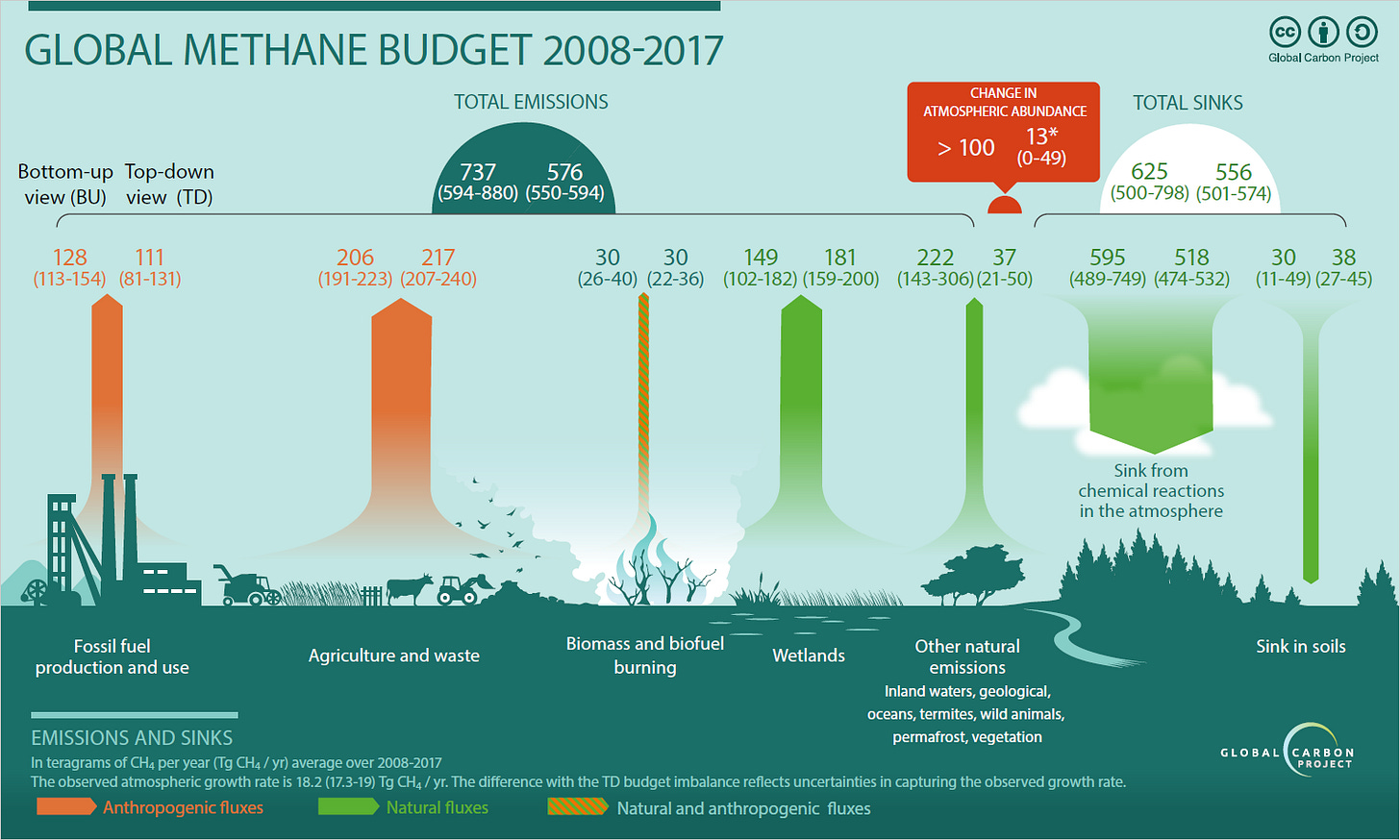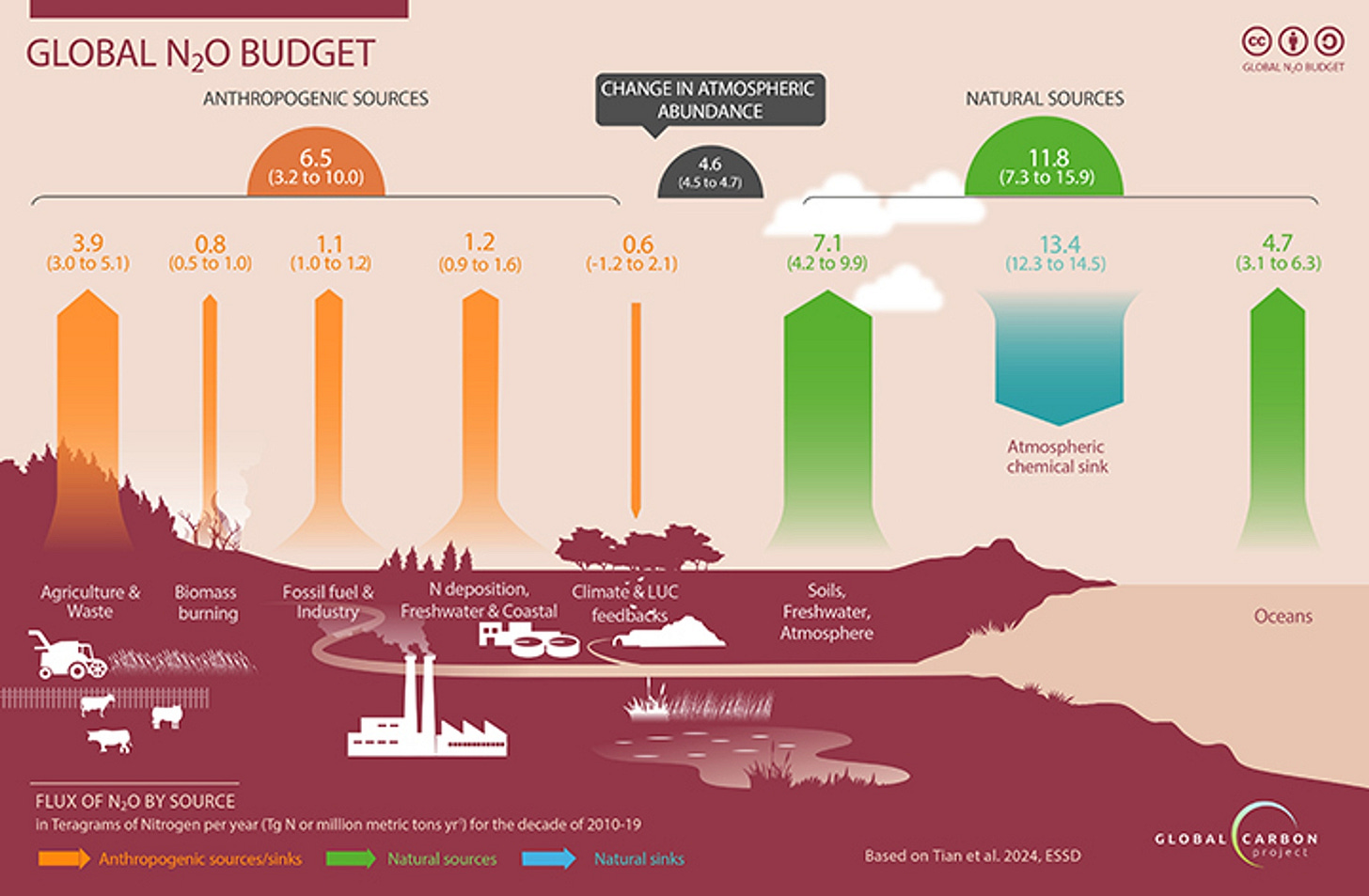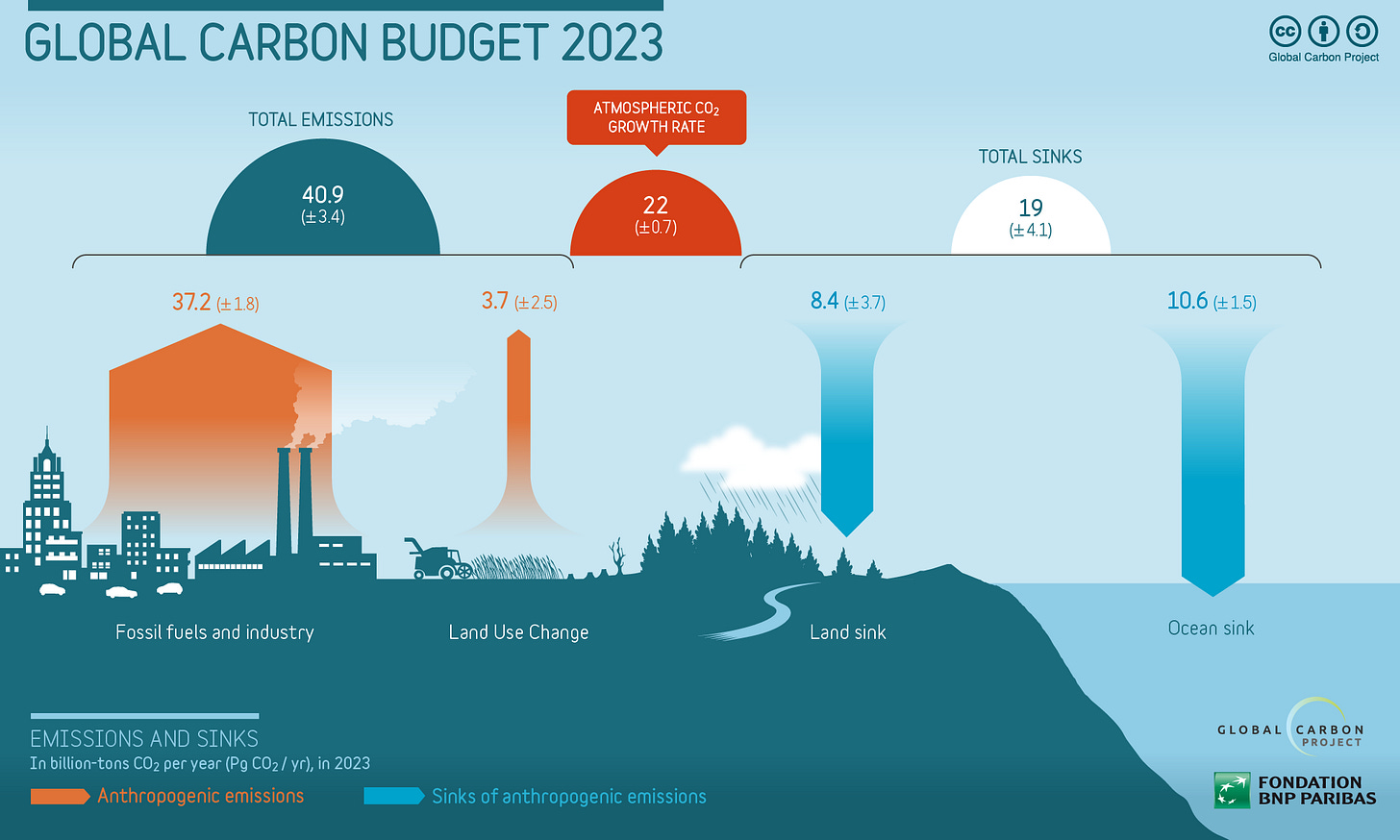This is part of a series of posts on how to pause climate change using technology and policy:
Net zero, part 4: agriculture (you are here)
Net zero, part 5: stopping climate change
In the short term, it’s better to pause climate change than revert to a pre-industrial climate. To pause climate change, it’s sufficient to achieve net zero emissions across the economy. Here we’re going to focus on getting to net zero in agriculture.
The net emissions from agriculture, livestock, and wildlife are tricky to assess. I think I’ve covered all the major contributions, but the relative importance could change with new evidence. What our policy should be regarding agriculture, and especially livestock, is the subject of serious debate. See the further reading section at the end.
Agriculture has complicated effects on radiative forcing
A wild plant collects CO2 from the atmosphere. It’s eaten by wild hog who then respires the carbon in the plant as CO2. How much net CO2 has the wild hog emitted?
A field of maize collects CO2 from the atmosphere. It’s fed to a farm raised pig who respires the carbon in the maize as CO2. How much net CO2 has the pig emitted?
The answer is (roughly) zero. Plants and animals are part of the biosphere; they consume and respire carbon, maintaining an equilibrium amount of carbon in the atmosphere.
Now some caveats. Agriculture is still a significant contributor to climate change because:
Animals, especially ruminants, emit methane and other greenhouse gases. While they aren’t adding carbon on net, they are shifting it to forms that have higher radiative forcing.
The effect of fertilizers is complex. On one hand they can decompose and release N2O, a potent greenhouse gas. On the other hand, they increase the biomass on the planet, sequestering carbon in net. Harmful algal blooms from fertilizer runoff damage local ecosystems while also sequestering carbon.
Fossil fuels are used to produce agrochemicals and are supplied to crops to increase yields. This non-biological carbon eventually ends up in the biosphere, increasing CO2 concentrations.
Agriculture changes how carbon is stored in soil. Clearing forests to grow crops releases carbon, growing forests for lumber stores carbon. The net effect of land use change globally is a release of CO2 and other greenhouse gases.
On balance, agriculture has a big effect on forcing, contributing significantly to climate change. Each contribution has to be dealt with differently since CO2 and other greenhouse gases need different policies.
A combination of carbon capture and solar radiation management (SRM) can get us to net zero in all these cases. I’m going to lump 1 and 2 together to cover non-CO2 emissions. Then we’ll look at the climate impact of agrochemicals from point 3. The land use change in point 4 is complicated and requires its own policy, but happens to be falling quickly.
Methane and N2O
I’m particularly uncertain about the calculations in this section.
Agriculture generates a lot of net methane and nitrous oxide. For example, ruminants like cows burp a lot of methane and microbes in the soil convert fertilizer to N2O.
These emissions are shorter lived than CO2 and should be addressed with SRM. Stratospheric SO2 injection is our most established form of SRM (but we still know too little about it). Let’s assume these emissions are dealt with via SO2 injection and consider the costs.
Here’s a nice graphic on methane emissions. The agriculture and waste emissions are the responsibility of farmers.
Methane has a lifetime in the atmosphere of 12.4 years. Over a 20 year period, 1 kg of methane provides a radiative forcing that is 81 times larger than 1 kg of CO2. I’ll assume that’s about the same for the 12.4 years it’s in the atmosphere. Make Sunsets has marginal costs of $0.27 to offset 1 tonne of CO2 equivalent for 1 year. So the total cost is 423E12 grams * $0.27/tonne * 81 * 12.4 = $115 billion/year.
For context, cows produce 160 kg of methane per year, so that comes out to $43. There are ways to lower these emissions by managing manure and agricultural waste. For ruminants in particular, there are feed additives to reduce methane emissions such as 3-NOP, seaweed, and tribromomethane. My sense is these can reduce cattle emissions by about 50%.
Here’s the chart for nitrous oxide:
Attributing 3.9 Tg of N2O to agriculture1, we get 3.9E12 g * $0.27/tonne * 273 * 109 = $31.3 billion/year.
So the total cleanup cost of agricultural methane and nitrous oxide is $146B/year, not insurmountable given the trillions in revenue made from meat and dairy. I think this number could get smaller as we learn more about the lifetime of SO2 in the atmosphere. If it lasts for 3 years instead of 1 year, these costs would fall by 3x. I also think Make Sunsets can lower their costs by significantly as they scale. This paper for example estimates dramatically smaller costs for SO2 injection. There’s also significant money saved by the fact that payments for SO2 injection are delayed in time2.
There’s several things I’m still confused about:
If emissions of these gases are relatively constant then they increase global temperature by a constant amount. Could there be a “temperature budget” where agriculture can add 0.3°C but any more must be cleaned up? This is the source of some debate, see the further reading section.
The net change in atmospheric abundance is slightly smaller. Should industry pay for that to reach zero? Or should the concentration fall?
Is there an equilibrium amount of methane or N2O that should be in the atmosphere?
We can’t do an arbitrary amount of SO2 injection each year. There is some evidence for a sweet spot in the amount of SRM we do; a little increases crop yields, but too much and yields will fall. That sets a limit for how much we should emit each year.
Fortunately, I don’t think agriculture is close to that limit, nor will it ever be. Per-capita methane is falling, so aggregate emissions should peak before the population peaks this century. And aggregate N2O emissions are already falling.
Agrochemicals
Modern crops owe their high productivity to dozens of chemicals. Fertilizer, urease inhibitors, herbicides, insecticides, plant hormones, soil conditioners, and so on.
These chemicals help us feed the world in a small amount of land. Aside from local environmental effects, they are typically made from fossil carbon3. Their degradation processes aren’t fully understood, but it’s a safe bet that their carbon eventually oxidizes to CO2. They likely have other effects on the concentration of methane and nitrous oxide.
At the very minimum, the new CO2 that these chemicals add to the biosphere should be cleaned up. Fortunately this comes at quite a small cost for most agrichemicals. Nitrogen fertilizer is a different story, which was addressed in part 3 of this series.
A comprehensive assessment of the emissions of different agrochemicals and the implications of a carbon tax is beyond the scope of this post. Instead, we’ll look at one major chemical, glyphosate, which will be representative of the rest of the category.
Glyphosate or Roundup is the most used pesticide in the world, with over 100,000 tons of active ingredient in 2014. Its contribution to CO2 in our atmosphere is among the largest in the sector. It’s also a relatively simple organic molecule, suggesting the cost is low and will be among the most impacted by a carbon tax.
Let’s assume that all three carbon atoms become CO2. The three CO2 molecules weigh 78% as much as the full molecule, so for each ton of glyphosate, we’re getting at most 0.78 tons of CO2 in the atmosphere. A $100/ton carbon tax adds $78 to the $5000-$10000 price tag, less than a 2% change.
This is indicative of other chemicals I’ve looked at. The potential carbon emissions pale in comparison to the price. The agrochemicals industry will be little affected by a carbon tax.
Land use change
Land use is the most confusing contribution on the list. Plants and soil microbes do some weird things in response to climate change and agriculture. It’s challenging to estimate CO2 emissions due to land use change so we are left with large error bars. It’s also hard to apportion emissions to agricultural changes and wildlife response. That said, the global carbon project is making a valiant effort, let’s use their estimates. There’s more detail in the report here.
With 3.7 billion tons/year of CO2 emitted from land use change, the total cost would be $370 billion/year. This is small relative to the $10 trillion in revenue for food products.
But who’s going to pay? It’s one thing to count the cows on a farm, but how do you measure changes in soil carbon across each acre of farmland? While it may be possible for governments with sophisticated tax technology to attribute land use emissions, taxing farmers has never been popular. As I’ll discuss in the final post of this series, land use emissions might get lumped in with other categories that are awkward to tax. Nations may just pay for their farmers emissions rather than tax them.
Another reason for states to foot the bill is that land use change emissions may be temporary. A given piece of land should emit a fixed amount of carbon as it transitions to agriculture. The amount of land we’re using for agriculture should stop growing as population peaks and land-efficient farming practices are adopted. Indeed, global per capita emissions from land use change have fallen sharply over the last 80 years. I expect a peak and decline in developing countries just like we’ve seen in developed countries. There’s no need to clear more land if there’s no new demand.
One thing I’m not sure about: there are significant natural carbon sinks. Stop emissions stop warming relies on those sinks to draw carbon down quickly enough to pause warming. But how quick do those have to be? Could we eliminate fossil fuel emissions and let the natural sinks cancel out the land use emissions?
Conclusion
Agricultural emissions are complicated. But these back of the envelope estimates suggest that cleaning them up won’t be a huge burden. In addition, agriculture is getting more efficient with respect to land and fertilizer use. I expect we’ll see increasing productivity per unit of pesticide or per unit of methane in the future.
Agriculture’s climate impact depends strongly on future population growth. Some researchers are arguing that the population will peak much sooner and much lower than UN projections4. If so, agricultural (and other) emissions will fall sharply.
Future demand for animal protein is another big factor. We use a startling amount of land to feed livestock. As the world gets richer, increasing per capita meat consumption can overpower farming improvements. Alternatives to meat, more efficient animal husbandry, and improved farming techniques can limit the effect on land use.
Appendix
Further reading
From growing things to making things a post arguing we should move away from relying on biology to make things, and how we might do that.
No, growing more food does not mean we always need more and more inputs
Prime Movers Lab has a nice review of ag-tech startups.
Report from the IPCC on land use change.
I want to highlight that there is an existing debate over what the emissions requirements should be for the livestock industry. Much of it centers around how we measure forcing for short lived pollutants like methane.
The livestock industry favors a version of global warming potential called GWP* that aligns with how I’ve structured my discussion here, namely, focusing on the forcing when short lived pollutants are emitted at a constant rate.
The climate science behind this seems reasonable, but more questionable is the livestock industries claims about reaching “climate neutrality”. That seems to mean that if an industry increases the temperature of the Earth by a fixed amount and holds there, then you are “climate neutral”.
Are climate neutrality claims in the livestock sector too good to be true?
Other ways to reduce ag emissions
Lower-meat diets, plant-based meat, kelp farming, cultured meat, precision fermentation, or synthetic meat can provide nutrients using much less land. See also: Lectrolyst and electro-agriculture.
GMO plants can lower land and chemical inputs per unit of output. GMO soy just got approved in the US. Further improvements in soy or cattle productivity might reduce emissions.
Feed from natural gas like Calysta reduces land use, but it also adds fossil carbon to the atmosphere, it’s not clear what the net effect on the environment is. See this linkpost on the efficiency of fuel to cows. Could captured CO2 to feed eventually beat plants?
Automating farming and supply chains with robots (with lasers!), vertical farming for veggies, and perhaps solar powered grow lights can boost productivity and lower chemical use.
Direct synthesis of oils, starch, and perhaps protein from captured carbon. See also: Food without agriculture.
Recycling biomass (sewage, compost, brush, crop residues, manure) into feed5 or soil amendments like biochar. See also the company Capro-X making a valuable product by fermenting dairy waste.
Reducing chemical use by recycling from runoff. See the section on reducing fertilizer use in the previous post.
The “N deposition” adds to the cost of fertilizer discussed previously.
With a 5% discount rate, the methane cost falls by only 20%, but for N2O it’s significant, over 5x smaller because many of the payments are decades in the future.
For this reason, it’s not a good idea to recycle plastic or fossil carbon into food. Better to recycle these products into plastic so they don’t enter the biosphere.
I would think GLP-1 inhibitors and population aging would combine to mean less food consumption per captita even in developed countries.
EDIT: This paper suggests we can get a lot of energy from things like crop residues. Their headline number of 33,000 TWh/year is more than 20% of current primary energy consumption. As an energy source, crop residues will be too expensive. I also doubt that biofuels can beat fossil fuels + DAC without subsidies.
Perhaps most valuable is converting biomass into animal feed via fermentation, thus dramatically reducing the resources we need to produce animal protein. This is particularly valuable in a future with higher CO2 fertilization, yields boosted by SRM, mechanical brush removal for wildfires, and a larger, richer population with more demand for meat.





